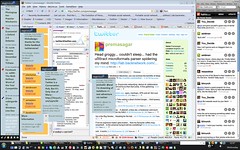 Image by be_khe via Flickr
Image by be_khe via Flickr
Unless you’ve been completely oblivious to the news during the past few weeks, it’s likely you’ve heard about the supposed “pandemic” that is sweeping the nation, the H1N1 virus, more commonly known as the Swine Flu. I know I’ve seen it all over in the news headlines, and have gotten precautionary e-mails from friends and family telling me to make sure to wash my hands…
But how can we tell which reports are informational and which are just unnecessary hype?
As we just read in our assigned readings for the week, the intro and Major Trends sections of “The State of the News Media”, the news is becoming less centralized, and as a result, less reliable. It states that, “through search, e-mail, blogs, social media and more, consumers are gravitating to the work of individual writers and voices, and away somewhat from institutional brand. Journalists who have left legacy news organizations are attracting funding to create their own websites.” And one of the main problems with this new trend away from big name news sources to smaller individual enterprises is that it is becoming increasingly difficult to make sure information is legitimate, which is particularly important during a global health crisis.
According to CNN.com, health officials fear that the decentralization of the media is causing people to turn more and more to social networking sites, specifically Twitter, for news information. This change may be adding to the unnecessary hype, and contributing to the promulgation of incorrect information that is leading people to make unwise decisions. For example, many tweeters cautioned their listeners to stop eating pork in order to avoid the flu, even though this assertion that the flu is caused by eating pork has not been approved by health officials.
While it is quite possible that Twitter is contributing to mass uninformed hysteria, it can still provide a lot of good. The statements without foundation or based purely on emotion are being contested by other Twitter users, providing for balanced discussion. Some health officials say Twitter is a good way to get people talking and thinking about the flu and is useful for giving out helpful and relevant information about disease prevention. In addition, users can get information about new outbreaks and recommended precautionary measures right from the Twitter updates from the Centers for Disease Control and Prevention.
Even though the decentralization of the media may make us more susceptible to falling prey to misinformation, I think this model for distributing the news has a lot of potential for the future. If internet users are smart and selective about what information they read and believe, then the shift away from well-known news industries can prove to be an even more effective means of conveying information, and can possibly save you from the dreaded Swine Flu.
![Reblog this post [with Zemanta]](http://img.zemanta.com/reblog_e.png?x-id=aaed07de-6c8c-4d93-9c3e-fc5942fdb174)
![Reblog this post [with Zemanta]](http://img.zemanta.com/reblog_e.png?x-id=1c35c6d3-9df0-4cae-81a9-db2dcee6acfa)

![Reblog this post [with Zemanta]](http://img.zemanta.com/reblog_e.png?x-id=2622dd3a-3874-4744-a27d-819299ec3722)

![Reblog this post [with Zemanta]](http://img.zemanta.com/reblog_e.png?x-id=30babe09-581a-4512-bceb-b7a74af3150d)